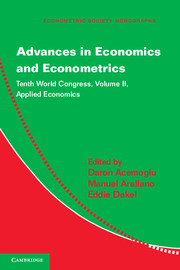Book contents
- Frontmatter
- Contents
- Contributors
- Preface
- I FINANCE
- II POLITICAL ECONOMY
- III MACROECONOMICS
- IV TRADE AND FIRM DYNAMICS
- 7 Trade Liberalization and Firm Dynamics
- 8 International Trade: Linking Micro and Macro
- V GROWTH
- VI FRISCH LECTURE
- VII PERSPECTIVES ON CHINESE ECONOMIC GROWTH
- Name Index
- Miscellaneous Endmatter
7 - Trade Liberalization and Firm Dynamics
Published online by Cambridge University Press: 05 May 2013
- Frontmatter
- Contents
- Contributors
- Preface
- I FINANCE
- II POLITICAL ECONOMY
- III MACROECONOMICS
- IV TRADE AND FIRM DYNAMICS
- 7 Trade Liberalization and Firm Dynamics
- 8 International Trade: Linking Micro and Macro
- V GROWTH
- VI FRISCH LECTURE
- VII PERSPECTIVES ON CHINESE ECONOMIC GROWTH
- Name Index
- Miscellaneous Endmatter
Summary
Introduction
Firms operating in the same country and industry respond to globalization in different ways. Empirical work using microlevel data on firms or plants initially highlighted this contrast for export decisions and how this decision correlates with observable firm-performance measures such as size and productivity: Only a subset of relatively bigger and more productive firms export. Subsequent work documented a wide-ranging set of other responses to globalization that consistently vary across firms in the same country and industry and also are strongly correlated with firm-level performance measures: the number and location of export destinations, entry and exit from the domestic market, range of products produced, international organization of production (including but not limited to multinational status and outsourcing/offshoring decisions), and innovation activities such as R&D.
This empirical work prompted the development of models with heterogeneous firms in open economies that capture how changes in the extent of globalization (i.e., indexing frictions to trade and foreign investment and the size of the global economy) influence those varied firm-level responses. These models highlight the composition effects that are induced by the different firm-level responses to globalization. To focus on those composition effects, the majority of models examine cases in which the firms' responses to globalization (i.e., export decisions, organization of production, and innovation) do not change over time. This assumes a stable aggregate environment with no firm dynamics.
- Type
- Chapter
- Information
- Advances in Economics and EconometricsTenth World Congress, pp. 283 - 328Publisher: Cambridge University PressPrint publication year: 2013
- 16
- Cited by



